|
Canine
Pregnancy Diagnosis
 p558-561 p558-561
 p 73-77 p 73-77

Abdominal Palpation
-
If
the bitch is at a stage of gestation which enables it, abdominal
palpation can be used to diagnose pregnancy.
-
Some skill and care are
required to adequately perform uterine palpation in the pregnant bitch.
Technique
-
It is usually best
to use one hand to palpate most dogs.
-
The abdomen is palpated from the
hepaxial muscles downward, attempting to slip the uterus between the
thumb and fingers.
-
In smaller dogs, one finger can be placed in the
rectum and used as a landmark for palpation.
-
The
non-pregnant uterus and the pregnant uterus before day 21 of diestrus is not reliably palpated in most dogs.
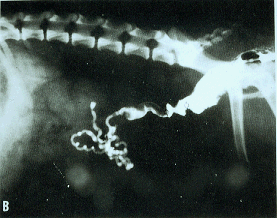
A contrast radiograph of a bitch's uterus in estrus
demonstrating how small it is. The faint black arrow is the cervix.
-
During pregnancy however, from day 21 to day 31
from the first day of diestrus, when the uterus slips between your thumb
and fingers you can fell 'walnuts', which are the distinct gestational
vesicles.
-
These vesicles average 1.5-3.5 cm between days 28-32 of
pregnancy.

Click on the movie icon, then right click on the movie or "Open
It" and "OK" to see
Canine Abdominal Palpation
A photo showing the distinct gestational sacs.
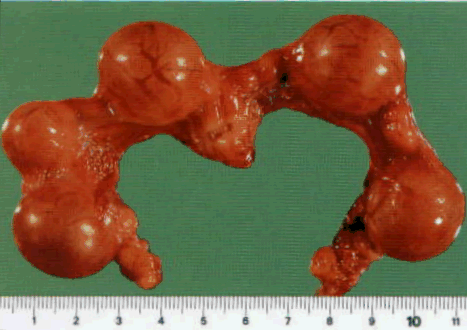
A photo showing how the gestational sacs become confluent,
and therefore difficult to distinguish.
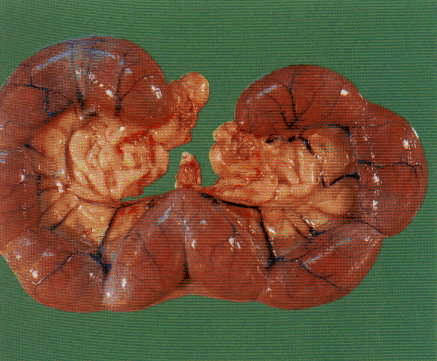
-
It is
difficult to accurately count the number of fetuses and the viability of
the pregnancy cannot be determined by abdominal palpation.
-
Some
dogs are too large to palpate and some tense the abdomen and make
palpation very difficult.
-
Some dogs carry the pregnancy more cranial,
therefore making palpation more difficult.
-
Mammary enlargement may also
make palpation difficult. On very large dogs, you may try to palpate
with two hands, but it is not the best way to palpate.
-
After day 31 the
gestational sacs become more confluent and lose their distinction.
However, after day 50 the puppies may be palpated
directly.
Ultrasound
-
(Yeager et. al. AJVR 53, 1992)
-
Gestational
sacs are visible as early as 18-20 days past the LH peak.
-
There is usually little doubt when
the black, hyperechoic gestation sac is observed, that the bitch is
pregnant.
-
Ultrasound is more accurate than
palpation at all stages than palpation or radiography.
-
The presence of
fetal heartbeat and fetal movement can accurately establish fetal
viability.
-
Predicting
gestation duration from
ultrasound measurements
| |
Less than 40 days |
More than 40 days |
|
Gestational Sac Diameter
(GSD) cm
|
GA = (6 X GSD) + 20
|
GA = (15
X HD) + 20
|
|
Crown-Rump Length
(CRL) cm |
GA = (3
X CRL) + 27
|
|
|
Head diameter
HD (cm) |
|
GA = (15
X HD) + 20
|
Ultrasound Sector Scan of Canine Pregnancy at 25 days.
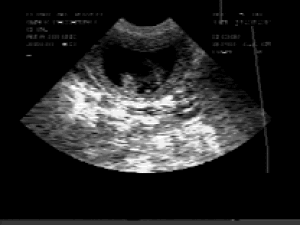
Click to see the structures identified.
Click on the movie icons below
to see ultrasound videos.

Ultrasound 25 days

Ultrasound 49 days

Ultrasound 52 days

Ultrasound 55 days
-
Ultrasound is especially useful between days d
33-45, because it is too late to palpate and too early for radiographs.
-
Counting the number of fetuses difficult, because you can never be sure
if you are seeing another fetus when you move the probe, or if it is the
same one.
-
Small litters may make it more difficult for ultrasound to be
used to diagnose pregnancy.
-
Ultrasound has great value in obstetrical
use in the determination of fetal viability.
-
The normal heart rate in
the fetus is 200 beats per minute.
-
An increase or decrease in the fetal
heart rate indicates fetal stress.
-
The absence of a heartbeat indicates
fetal death.
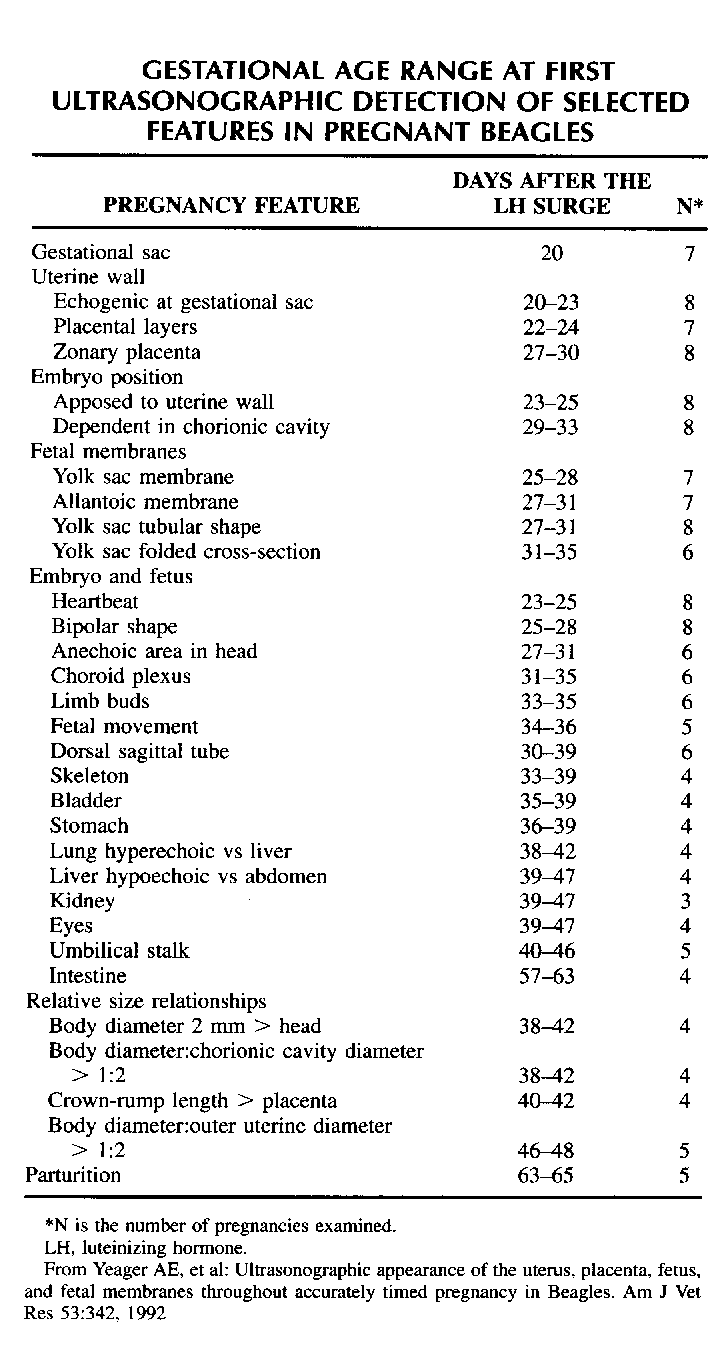
Radiographic
-
The
fetal skeleton becomes opaque 43-46 days after the LH peak making
radiographic diagnosis of pregnancy possible 45-48 d after LH peak.
-
Bones become visible at different times (see Rendano, Current Veterinary
Therapy VIII, Kirk, ed.); for example, teeth are visible approximately 4
d before birth.
-
After 50 days you can count the
number, estimate size, and estimate the position of fetuses.
-
At LSU we
routinely do a radiographic 'puppy count' to determine how many pups
there are.
-
This makes the attendant at whelping much more aware if
whelping is done, or if assistance is needed.
-
No negative effects have
been seen in fetuses that were radiographed during the latter stages of
gestation.
-
Fetal Death
Signs of fetal death can be
visible to the trained eye.
-
An alteration of fetal
skull bone alignment with overriding or extreme deformity is a sign of
fetal death.
-
Intra- or peri- fetal gas accumulations indicates fetal
death.
-
Abnormal fetal posture such as the
"ball sign" which is the increased flexion or straightening of
hind limbs.
Can you see the pregnancy in this radiograph? No one can. The bitch is
pregnant, however the uterine enlargement which is visible cannot be
definitively diagnosed as a pregnancy. It may be a pyometra.
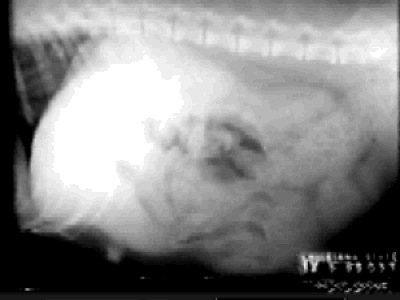
On this radiograph the fetal
skeletons are actually visible. .
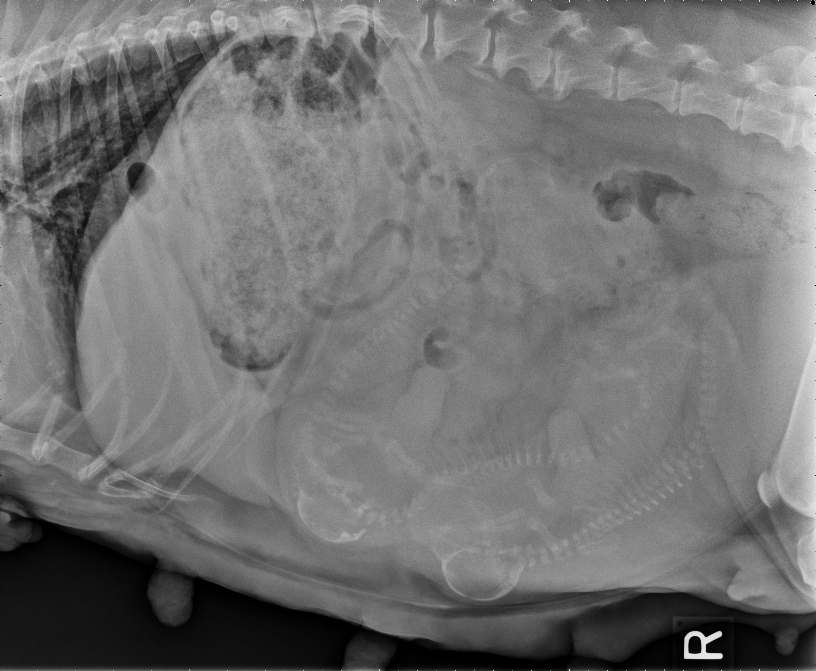
(Click on the image to see a larger picture)
Hormonal
-
Relaxin is first observed at 20-30 d gestation and is
present for 30-60 d postpartum.
-
A test is marketed
by
Symbiotics - ReproCHEK 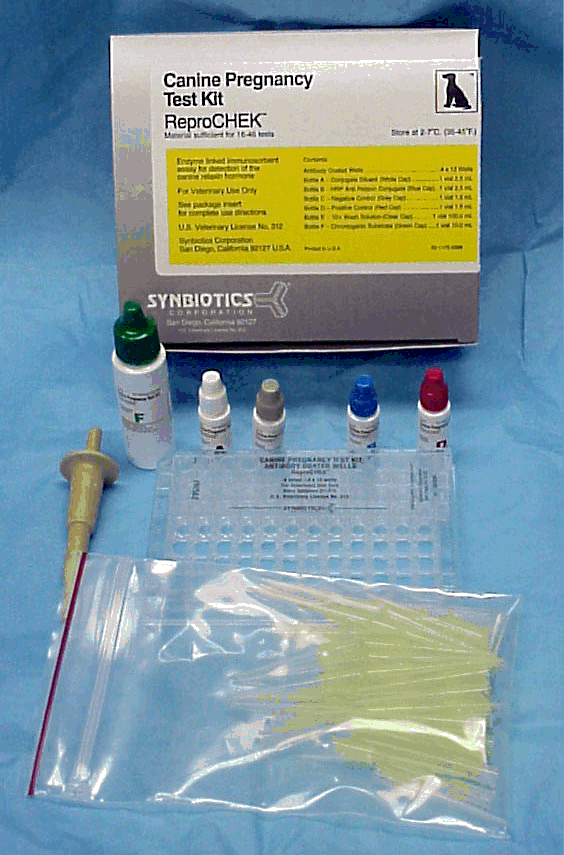
-
The test
seems good, but you must buy 16-40 tests (depending on how many you run
at once) for $240 (one year shelf life). If you only test dogs
occasionally, then the price is pretty high.....how about ultrasound.
-
Witness Relaxin
-
5 Tests/box
-
Room temperature storage
-
10 minute running time
-
Cost $78/5 tests

Acute phase proteins
-
Acute
phase proteins are present 28-37 days after the last breeding.
-
A company
(ICAGEN) marketed a mail in kit that claimed 95% accuracy, however the
test is unavailable at this time.
|
 Canine
Index
Canine
Index Next
Page
Next
Page Canine
Index
Canine
Index Next
Page
Next
Page